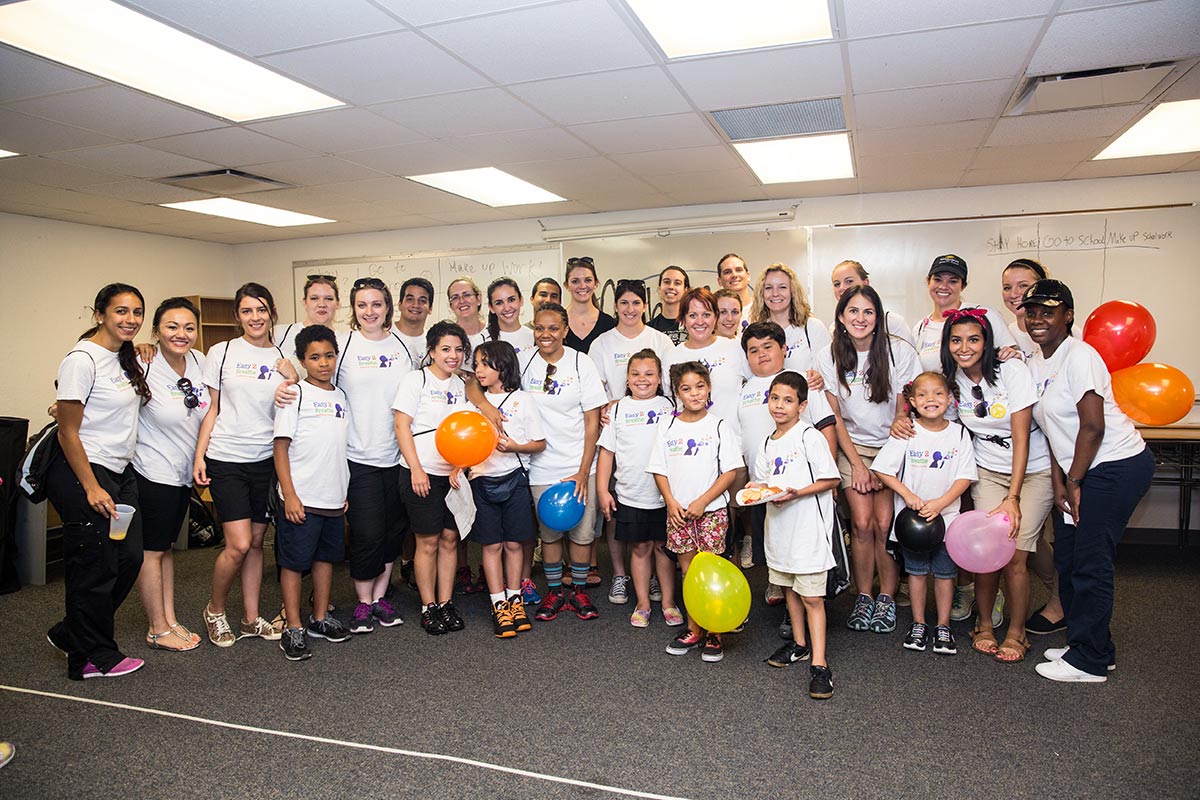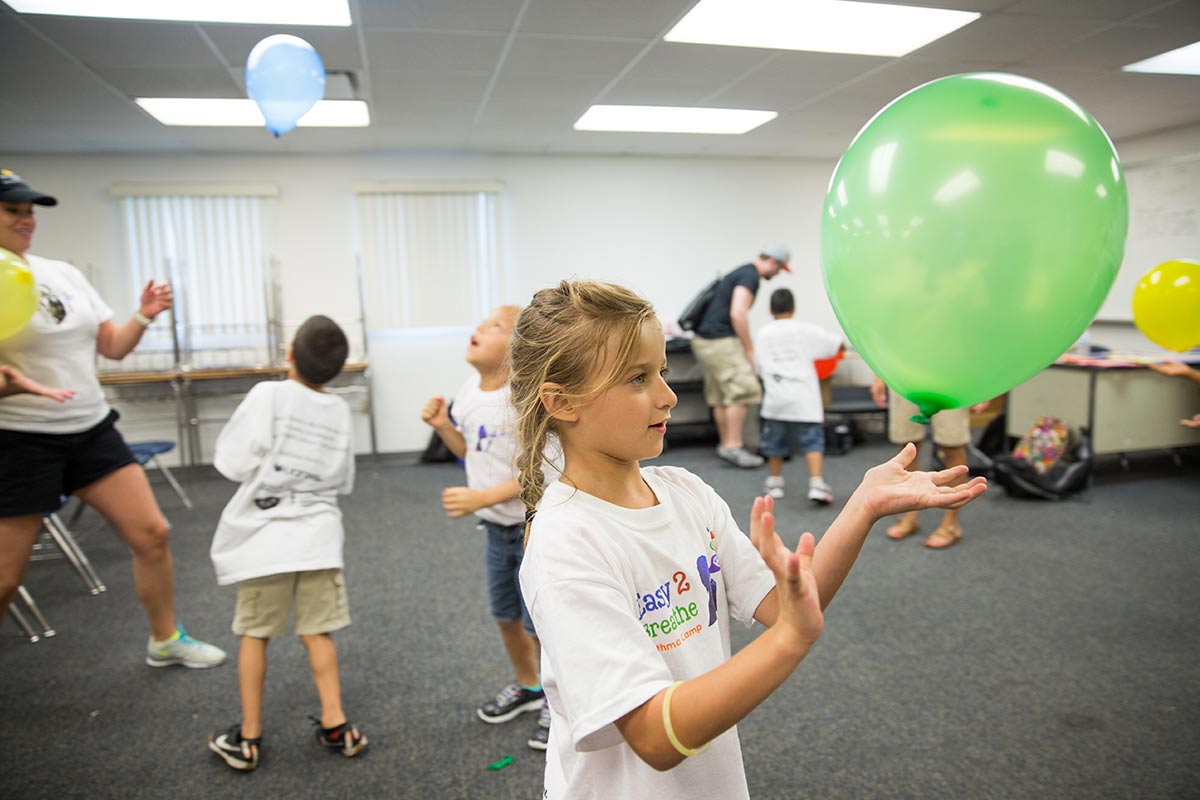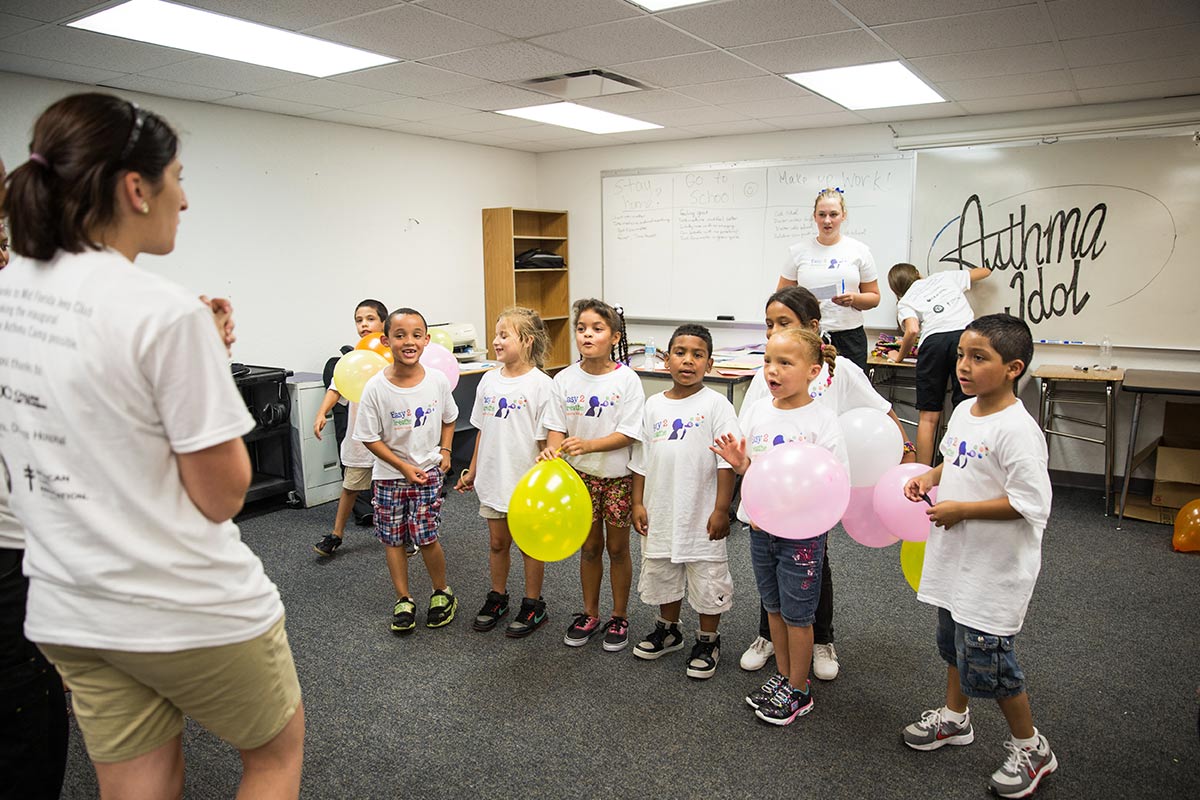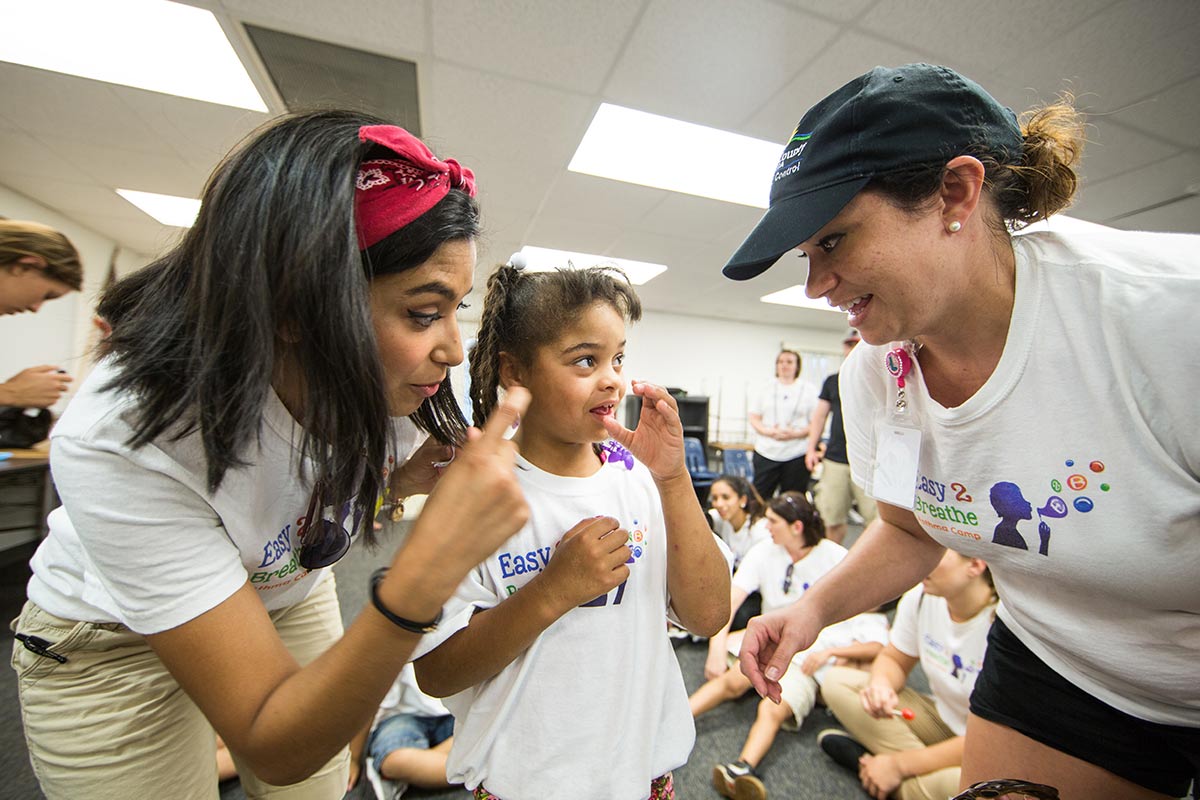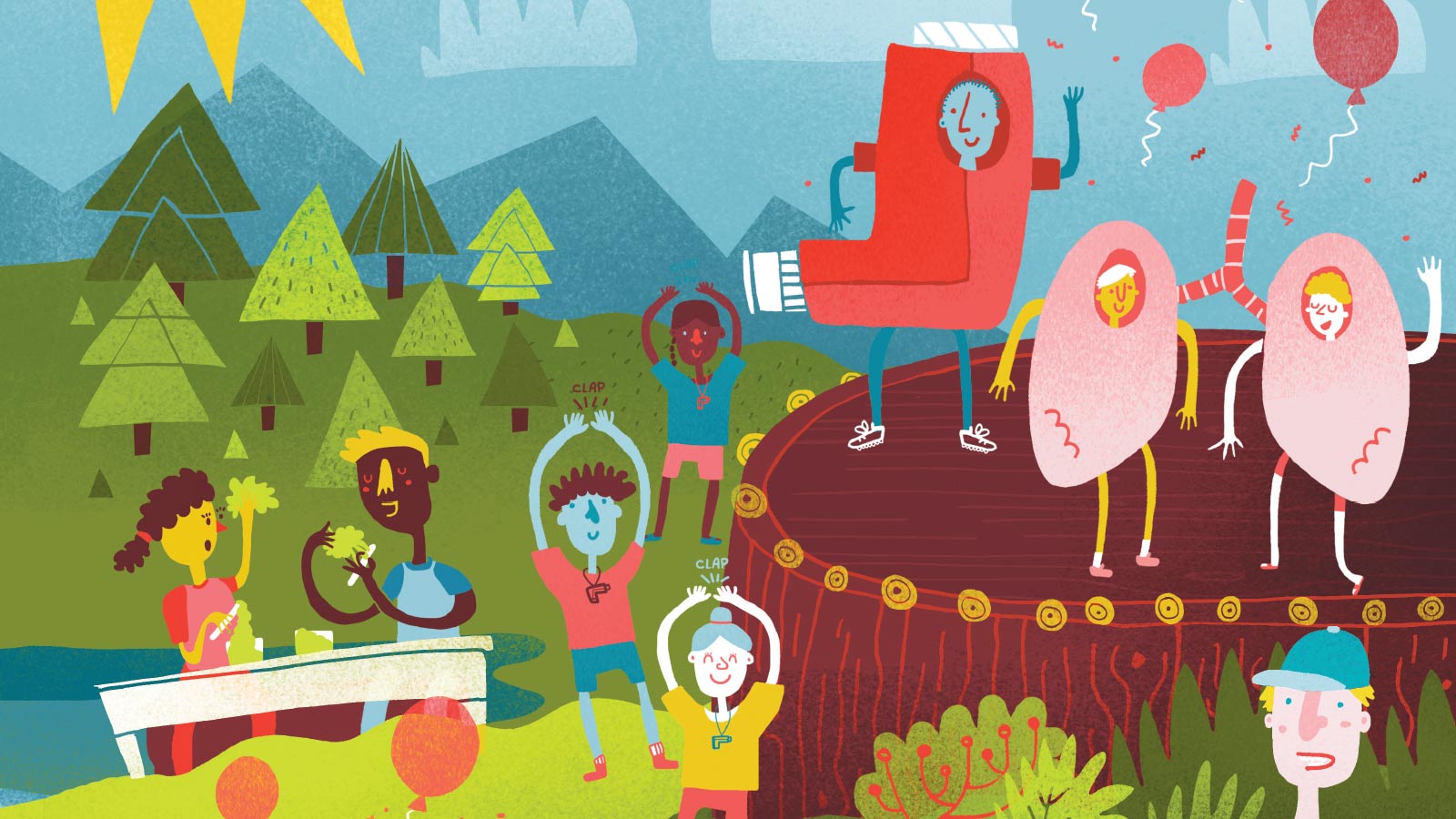
Breathe Easy
Fall 2014
Jaksael Moreno leaped to swat at a red balloon as it sank slowly in the air. He missed and lunged for another before it hit the floor. Like a pack of rowdy puppies, the 7- and 8-year-olds around him in the classroom dashed and tumbled to keep the floating targets aloft. The camp counselors supervising the frolic were alert; any sort of physical activity is a scary situation for a group of children with asthma who might not recognize when too much fun quickly becomes an emergency. But kids — even ones with asthma — will be kids.
Finding her happy son after playtime, Moreno’s mother, Jessica, smiled. “This is the first time he’s been with so many kids with asthma.”
Like her son, the other boys and girls at Camp Easy 2 Breathe wore belt packs carrying inhalers and peak flow meters to test their lung capacity. Two nurses with an oxygen tank stood at the ready. Youthful exuberance wasn’t something to tolerate — it was a reason to celebrate. And for camp founder Linda Gibson-Young, an assistant professor at the College of Nursing, watching children with asthma chase balloons was a small victory in a long battle. Keeping children with asthma out of the emergency room is Linda Gibson-Young’s goal.
What is an Asthma Attack?
When an asthma attack occurs, the linings of the airways in the lungs swell as the muscles around them contract and mucus production increases, causing coughing, chest tightness, wheezing, difficulty in breathing and sometimes asphyxiation.
Preventing Emergencies
Before joining the UCF faculty in 2011, Gibson-Young was a pulmonary nurse who worked with what seemed like an endless line of children who came into the emergency room suffering from painful and sometimes-fatal asthma attacks — many of which were preventable.
“It was heartbreaking to see those children suffer needlessly,” she says.
Most of the children Gibson-Young treated in that Birmingham, Alabama, ER came from low-income homes. She knew firsthand the challenges all families face when they have a child with a chronic illness. Her own son, Greyson, was diagnosed with asthma in 2010. That experience helped clarify her mission: “My goal in life is to make a difference in the lives of kids with asthma.”
Asthma is the third-leading cause of preventable hospitalization in Florida. As defined by the Florida Department of Health, it is a chronic lung disease characterized by inflammation of the airways and recurring attacks of symptoms such as wheezing, coughing and chest tightness. Inflammation makes the airways sensitive to common irritants such as smoke, pet dander, pollen, mold, chemicals and other airborne triggers. Currently, there is no cure for asthma, but it can be controlled through medical treatment and environmental management. That control starts with education.
In Osceola County, the number of children visiting emergency rooms because of pediatric asthma is one of the highest in the state. More than 22 percent of the county’s children under the age of 18 have had at least one asthma attack. So Gibson-Young approached Barbara Meeks, chief nurse executive at Nemours Children’s Hospital in Orlando, about partnering to create an asthma camp. Meeks was on board immediately. She had run medical camps in other states and knew they made a positive impact not only on the children attending them, but also on ER staff swamped with asthma cases.
With support from Nemours and a staff of UCF nursing students, Gibson-Young launched Camp Easy 2 Breathe based on the American Lung Association’s curriculum for children ages 6 to 12. The four-day camp offers activities designed to get kids thinking about how their illness works, such as scavenger hunts highlighting attack triggers and making lung puppets out of paper sacks and construction paper. Children also learn lung-strengthening exercises and participate in physical activities that teach them how to recognize their limits and avoid an attack that may lead them to an emergency room.
“This is the time when children are beginning to take responsibility for their asthma but may not know yet how to look for symptoms,” Gibson-Young says. “That’s where we help.”
This is the time when children are beginning to take responsibility for their asthma but may not know yet how to look for symptoms.
Linda Gibson-Young
Asthma In Florida
A 2013 study by the Florida Department of Health shows:
1 in 10 children in Florida suffer from asthma.
Children with asthma miss about 3 times as much school as other students.
Youth with asthma are at increased risk for depression.
Asthma is the third-leading cause of preventable hospitalization.
In 2012, 47,733 children ages 0 to 17 visited emergency rooms for asthma-related issues.
13 children ages 0 to 17 died of asthma-related causes in 2012.
80% of asthma-related deaths are preventable with proper education and management.
1 in 10 children with lifetime asthma (or their parent) have taken a course on how to manage their asthma.
1 in 3 children with lifetime asthma have received an asthma action plan from a health professional.
Managing Asthma
Children squeezed slimy, green “mucus” between their fingers. They were mixing a sticky concoction of cornstarch, water and green food coloring to help them better understand their asthma.
“What happens when you squeeze the mucus?” a counselor asked. “Imagine mucus in your body — why is it difficult to breathe?”
“It plugs up your lungs,” a child responded.
“Normalization is a big part of what we do here,” said Melody Wallace, a child life specialist at Nemours. The arts and crafts projects are a way to introduce topics to campers that they may not feel comfortable talking about with non-asthma sufferers. And normalization is the key to getting the children to discuss their challenges.
“So,” asked student nurse Tamesha Rolle, ’14, “what are some of your triggers?”
“Smoke!” yelled one of the boys. “Pollen!” said another. “Cleaning products!”
“Good. Any more?” asked Rolle.
“Barbie stickers!” a boy shouted out, getting a laugh from the campers and counselors.
The trigger activity set the stage for a special visitor to the camp. Rebecca Campbell, an asthma sufferer on the UCF women’s rowing team, told the children about her first attack.
“I noticed my chest felt a little heavy, and I couldn’t get in a full breath of air,” she recalled. “I started to panic and cry, which only made things worse. I had heard of asthma before from classmates in elementary school, but I didn’t recognize what was happening to me.” Fortunately, her coach recognized that it was an asthma attack and encouraged Campbell to see a doctor after calming her down.
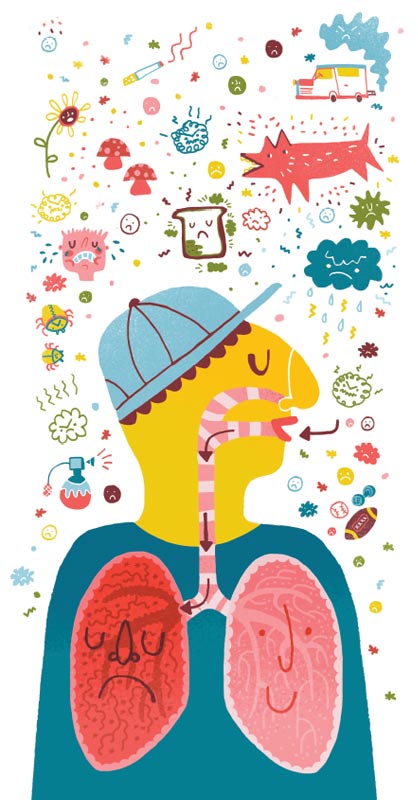
I noticed my chest felt a little heavy, and I couldn’t get in a full breath of air. I started to panic and cry, which only made things worse. I had heard of asthma before from classmates in elementary school, but I didn’t recognize what was happening to me.
Rebecca Campbell
Rather than backing away from sports, Campbell learned to use an inhaler, cool down with a wet towel over her forehead and take belly breaths when she found it hard to breathe.
“I lived through it, altered my workouts and was forced to find ways to manage on my own,” she said. “You can find middle ground of being athletic and living with asthma — I’m proof of that.”
Gaining Perspective
Standing on one foot and pulling on his ears, Freddy Roman, ’14, had every camper’s attention.
“Freddy says, hop up and down.” The giddy campers hopped.
“Stop!” Roman cried. A few did. “Aw! Freddy didn’t say!”
The remaining campers continued to jump in earnest as Roman watched, monitoring their stamina until he finally gave the order. “Freddy says, stop!”
The kids collapsed into a pile of giggles — still holding their ears.
Roman, along with 36 other nursing students from UCF’s Daytona Beach campus, probably never thought a game of Simon Says would be part of his education. But practical experience garnered from volunteering is an important step for the students, and Camp Easy 2 Breathe provided an integral lesson in working with children. As they educated the campers about their disease, students witnessed the complications and psychological toll that asthma can take on a young patient.
“Some [students] are learning they have a knack for working with kids, while others see the challenges young patients present,” says nursing professor Angeline Bushy, who observed her students in action. “This has been great for them.”
Nursing student Crystal Blankenship, ’14, agrees. “You can only read so much about asthma or any medical condition, but when you actually see it and experience it, the knowledge solidifies much quicker.”
For camp founder Linda Gibson-Young, an assistant professor at the College of Nursing, watching children with asthma chase balloons was a small victory in a long battle.
Children ages 6 to 12 from the Kissimmee area were invited to the camp which was created for at-risk youngsters who don't have access to regular health care that could help them manage their asthma.
The four-day camp offers games and activities designed to get kids thinking about how their illness works and how they can respond to symptoms before an asthma attack occurs.
At Camp Easy 2 Breathe, which tapped UCF nursing students as staff, youthful exuberance wasn’t something to tolerate — it was a reason to celebrate.
Moving Forward
Stomp, stomp, clap. Stomp, stomp, clap.
Entering the classroom filled with their parents and caregivers, the campers wiggled with excitement as they took their places, ready to perform their final skit. Gibson- Young, who spent most of her previous few days flitting around each activity, finally stood still — soaking in the last minutes of camp.
Stomp, stomp, clap. Stomp, stomp, clap.
“We will, we will, BREATHE WELL!” the children chanted.
From the back of the room, counselor Blankenship cheered.
“They are fully capable of doing more than most people give them credit for,” she says. “I saw children looking out for each other, knowing when to tell an adult that their campmate was having trouble breathing. [They] were taking responsibility for their own asthma as well as for others. It was amazing.”
For parent Cherie Dwyer, who collected her 9-year-old son Sean after the skit, there were many good lessons to take home from the camp. “He learned a lot and enjoyed making friends,” she says. “He’s better at taking his medicine — he now knows that it helps him, and he wants to stay healthy.”
“This is the beginning of a strong community partnership,” says Gibson-Young. “The community of Kissimmee wrapped their arms around us with food donations for our asthma campers and families. We expect to continue this camp in the future and add more in Central Florida communities.”
